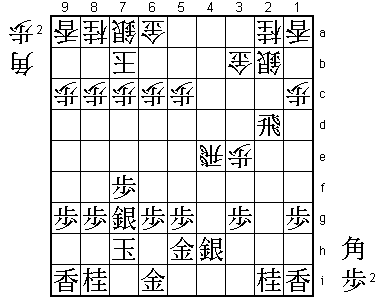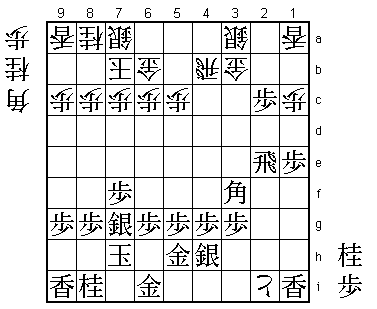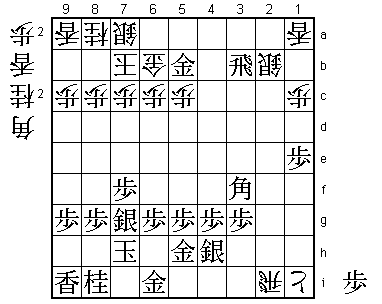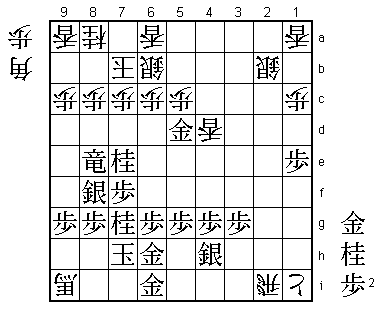58th Oza Match Game 1
[Black "Habu Yoshiharu, Oza"]
[White "Fujii Takeshi, Challenger"]
[Event "58th Oza-sen, Game 1"]
[Date "September 9th 2010"]
1.P7g-7f 00:00:00 00:00:00
Habu has won 18 consecutive Oza titles, with the last five of them ending in straight
3-0 victories. An amazing record and definitely something that will have been on Fujii's
mind before this match. But then again, every winning streak has to end somewhere and
with the score all blank before the first game, anything is possible. Fujii did lose the
first little contest, as three pawns resulted from the furigoma, giving Habu the black
pieces.
2.P3c-3d 00:00:00 00:01:00
3.P2g-2f 00:01:00 00:01:00
4.R8b-4b 00:01:00 00:02:00
5.S3i-4h 00:03:00 00:02:00
6.K5a-6b 00:03:00 00:07:00
7.K5i-6h 00:06:00 00:07:00
8.B2bx8h+ 00:06:00 00:09:00
Fujii is famous for reviving the Furibisha with the Fujii System, but recently he has
been changing his style a little, playing both Furibisha and Ibisha. Like almost all
of the top players he is trying to become an all-round player, and his possible choice
of opening had been discussed extensively before the start of this game. Anything
seemed possible, but playing this Furibisha opening came as a surprise. Fujii has
played the early bishop exchange on numerous occasions, but he has a unusual number
of crushing defeats in this opening, which doesn't seem to fit his temperament well.
9.S7ix8h 00:07:00 00:09:00
10.K6b-7b 00:07:00 00:09:00
11.K6h-7h 00:20:00 00:09:00
12.S3a-2b 00:20:00 00:10:00
13.S8h-7g 00:24:00 00:10:00
14.P3d-3e 00:24:00 00:35:00

This is what Fujii had prepared for the first game. The plan is to play S3c followed
by R2b next. After that the counter attack on the 2nd file is very strong, so black
cannot play this position quietly.
15.P4g-4f 00:48:00 00:35:00
Habu admitted after the game that this was probably risky, but there doesn't seem
to be much of an alternative. After 15.P2e S3c it is even easier for white to counter
on the second file, especially because black cannot support the pawn on 2e with a
knight on 3g because white has pushed the pawn to 3e early.
16.P4c-4d 00:48:00 00:47:00
White doesn't hesitate to attack the 4th file.
17.P2f-2e 00:52:00 00:47:00
18.P4d-4e 00:52:00 01:00:00
White pushes on. Here 18.S3c would be a mistake because of 19.B*5f and black both
defends against the pawn exchange on 4e and puts more pressure on the 2nd file.
After 18.P4e, both sides get the pawn exchanges that they aimed for.
19.P4fx4e 00:58:00 01:00:00
20.R4bx4e 00:58:00 01:00:00
21.P2e-2d 01:05:00 01:00:00
22.P2cx2d 01:05:00 01:00:00
23.R2hx2d 01:05:00 01:00:00
24.G4a-3b 01:05:00 01:03:00
25.G4i-5h 01:08:00 01:03:00

26.G6a-6b 01:08:00 01:53:00
Fujii looked long and hard at 26.N3c before finally settling for strengthening
the castle with 26.G6b. The plan after 26.N3c is easy, because white threatens
to trap the rook with P*2e next. Black seems to be in a little trouble, but after
27.B*3d! R4a P*2c S3a Bx6a+ Kx6a G*2b white has to play the double edged B*1e. Driving
back the rook is important and after R2h P*2g followed by P*2f it seems like white can
keep his position together and cash in on the material advantage. However, dropping
the bishop on 1e makes this bishop a liability and the white position is so disorganized
that a minor mistake could mean disaster. This is especially likely in a one day title
match game, so Fujii decided against this.
27.P1g-1f 01:22:00 01:53:00
Now B*1e is no longer possible in the variation above. However, this pawn push also
has a different meaning.
28.N2a-3c 01:22:00 02:12:00
29.B*5f! 01:33:00 02:12:00

This bishop is very well positioned. Not only for an attack on the second file, but
it also supports an attack on the first file after P1e followed by P1d.
30.R4e-4b 01:33:00 02:23:00
31.P*2c 01:49:00 02:23:00
In the press room the alternative 31.B6e was analyzed, which looks good because the
threat Bx3b+ followed by G*4c seems hard to defend against. However, after 32.B*5d
Bx5d Px5d Rx5d R4a! is a subtle move which stops the black attack.
32.S2b-3a 01:49:00 02:24:00
33.P1f-1e 01:54:00 02:24:00
34.P3e-3f 01:54:00 02:27:00
35.P*4g 01:56:00 02:27:00
36.N3c-4e 01:56:00 02:54:00
37.R2d-2e 02:06:00 02:54:00
38.P*2h 02:06:00 03:14:00
39.B5fx4e 02:24:00 03:14:00
40.P2hx2i+ 02:24:00 03:23:00
41.B4ex3f 02:25:00 03:23:00

42.+P2ix1i? 02:25:00 03:50:00
An important mistake that is caused by an oversight much later in the game. Correct
was 42.P*3e and only after the rook moves away from the second file with 43.Rx3e,
white plays 44.Px1i+ which leads to a difficult position. For example, 45.P2b+ Sx2b
N*3d R4a Nx2b+ Gx2b P*2c B*4d! or 45.N*3d R4c Nx2b+ B*1g and white seems to have
chances to counter attack.
43.P2c-2b+ 02:34:00 03:50:00
44.G3bx2b 02:34:00 04:05:00
45.N*3d 02:38:00 04:05:00
46.R4b-3b 02:38:00 04:05:00
47.N3dx2b+ 02:38:00 04:05:00
48.R3bx2b 02:38:00 04:05:00
49.R2ex2b+ 02:58:00 04:05:00
50.S3ax2b 02:58:00 04:05:00
51.R*3b 02:59:00 04:05:00
52.R*2i 02:59:00 04:06:00
53.G*5b 03:11:00 04:06:00

54.N*8e 03:11:00 04:27:00
Here Fujii realized that he had made a mistake. His original plan was to play 54.N*5d
here. This looks like a very good move because it is blocking the diagonal of the black
bishop to the king and at the same time helps to attack the black king. However, after
54.N*5d black has the strong 55.Gx5c and after 56.N*6f Sx6f Nx6f K7g there is a mating
threat against the white king so white loses. The alternatives to 54.N*8e are 54.L*6a
but this fails to 55.P*2g (threatening to take the silver on 2b) or 54.B*4c which seems
unclear after 55.Gx6b Sx6b G*8b K6a R4b+ B1f, but in the post-mortem analysis no variations
were found that were actually winning for white.
55.G5h-6h 03:43:00 04:27:00
The problem. Black now has a strong castle and can go for the knight on 8e. An extra
knight would give the black attack decisive strength.
56.L*6a 03:43:00 04:34:00
57.S7g-8f 03:57:00 04:34:00
58.P*3e 03:57:00 04:55:00
59.B3f-4e 04:06:00 04:55:00
60.B*2c 04:06:00 04:55:00
61.G5bx6b 04:12:00 04:55:00
62.S7ax6b 04:12:00 04:55:00
63.R3bx3e+ 04:14:00 04:55:00
64.B2cx4e 04:14:00 04:56:00
65.+R3ex4e 04:14:00 04:56:00
66.B*3c 04:14:00 04:56:00
67.G*4d 04:27:00 04:56:00
68.G*5d 04:27:00 04:56:00
69.G4dx5d 04:33:00 04:56:00
70.B3cx9i+ 04:33:00 04:56:00
71.B*4d 04:36:00 04:56:00
72.N*7g 04:36:00 04:58:00
73.N8ix7g 04:39:00 04:58:00
74.L*4b 04:39:00 04:59:00
75.+R4ex8e 04:40:00 04:59:00
76.L4bx4d 04:40:00 04:59:00
77.N*7e 04:40:00 04:59:00
Resigns 04:40:00 04:59:00

White has been struggling to make something out of nothing for a while, but finally
Habu has been given the time to drop the knight and end the game. The simple threat
is Nx8c+ and mate, but there is no proper defense. For example, 78.B*9d leads to mate
after 79.Nx8c+ Bx8c +Rx8c Kx8c N*7e etc. Also, white's only check is 78.B*8i, but there
is no follow-up after 79.K7i. No defense and no mate, so Fujii resigned here. This adds
another loss in a short game in this opening for Fujii and adds another win to Habu's
winning streak in the Oza which now stands at seventeen. Still, every loss only counts
as one so Fujii will get a chance with the black pieces to even the match in game 2.





